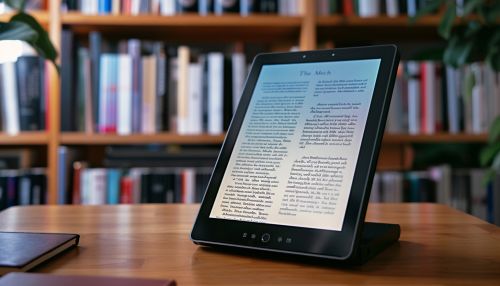Electronic Paper
Introduction
Electronic paper, also known as e-paper, is a display technology designed to mimic the appearance of ordinary ink on paper. Unlike conventional backlit flat panel displays, electronic paper reflects light like paper and is capable of holding text and images indefinitely without drawing electricity, while allowing the image to be changed later. This technology is widely used in e-readers, digital signage, and other applications where readability in direct sunlight and low power consumption are critical.
History and Development
The concept of electronic paper dates back to the 1970s when Nicholas K. Sheridon at Xerox PARC developed the first e-paper, known as Gyricon. Gyricon consisted of tiny beads that rotated to display different colors. However, it was not until the late 1990s and early 2000s that e-paper technology began to mature and find commercial applications, largely due to the development of electrophoretic displays by E Ink Corporation.
Technology
Electrophoretic Displays
Electrophoretic displays (EPD) are the most common type of electronic paper. They operate by moving charged pigment particles suspended in a clear fluid to the surface of the display using an electric field. These particles can be black, white, or colored, and their movement creates the visible image. The most well-known implementation of this technology is E Ink, which is used in many e-readers such as the Amazon Kindle.


Electro-wetting Displays
Electro-wetting displays (EWD) use voltage to change the shape of a liquid droplet on a hydrophobic surface, which in turn changes the optical properties of the display. This technology offers faster refresh rates and better color reproduction compared to electrophoretic displays, making it suitable for applications requiring video playback.
Electromechanical Displays
Electromechanical displays, such as Gyricon, use rotating balls or cylinders embedded in a substrate. Each ball or cylinder has different colored hemispheres, and by applying an electric field, the balls or cylinders rotate to display the desired color. This technology, while innovative, has largely been supplanted by more advanced methods.
Organic and Polymer-Based Displays
Organic and polymer-based displays utilize organic compounds that change their optical properties in response to an electric field. These displays are flexible, lightweight, and can be produced using roll-to-roll manufacturing processes, making them suitable for applications requiring bendable or foldable screens.
Applications
E-Readers
E-readers are the most widespread application of electronic paper. Devices such as the Amazon Kindle, Barnes & Noble Nook, and Kobo eReader use e-paper displays to provide a reading experience similar to that of printed books, with the added benefits of adjustable font sizes, built-in dictionaries, and the ability to store thousands of books in a single device.
Digital Signage
Electronic paper is increasingly used in digital signage, particularly in environments where readability in bright light and low power consumption are important. Examples include bus stop schedules, retail price tags, and public information displays.
Wearable Technology
Wearable devices, such as smartwatches and fitness trackers, benefit from electronic paper displays due to their low power consumption and readability in various lighting conditions. This allows for longer battery life and better visibility outdoors.
Electronic Shelf Labels
Retailers use electronic shelf labels (ESLs) to display product prices and information on store shelves. E-paper displays in ESLs can be updated remotely, reducing the need for manual price changes and ensuring pricing accuracy.
Advantages and Limitations
Advantages
- **Low Power Consumption:** Electronic paper only uses power when changing the displayed image, allowing devices to have extended battery life.
- **Readability:** E-paper displays are highly readable in direct sunlight, unlike conventional LCD or OLED screens.
- **Flexibility:** Some e-paper technologies can be made flexible, enabling new form factors for devices.
Limitations
- **Refresh Rate:** E-paper displays generally have slower refresh rates compared to traditional displays, making them less suitable for video playback.
- **Color Reproduction:** While advancements have been made, e-paper still lags behind LCD and OLED in terms of color vibrancy and accuracy.
- **Durability:** Some e-paper displays can be more fragile compared to other types of screens, particularly those that are flexible.
Future Developments
The future of electronic paper technology looks promising, with ongoing research aimed at improving color reproduction, refresh rates, and flexibility. Innovations such as color e-paper, foldable displays, and integration with other technologies like touch screens and solar cells are expected to expand the range of applications for electronic paper.
